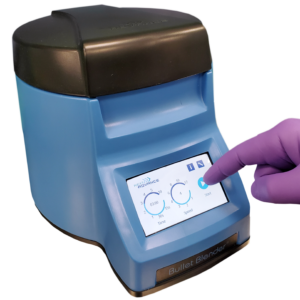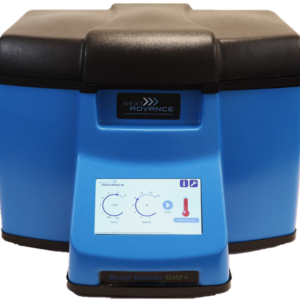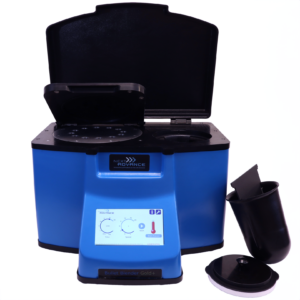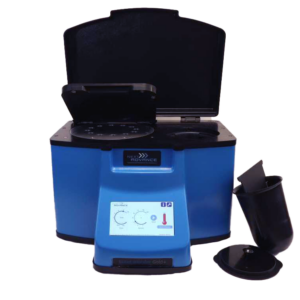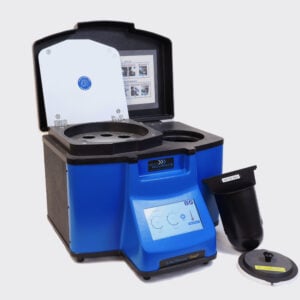Ideal for Extracting Intact Organelles
Do you spend lots of time and effort isolating intact organelles from cells or tissues? The Bullet Blender® tissue homogenizer delivers high quality and superior yields. No other homogenizer comes close to delivering the Bullet Blender’s winning combination of top-quality performance and budget-friendly affordability.
Save Time, Effort and Get Superior Results with
The Bullet Blender Homogenizer
Consistent and High Yield Results
Run up to 24 samples at the same time under microprocessor-controlled conditions, ensuring experimental reproducibility and high yield. Process samples from 10mg or less up to 3.5g.No Cross Contamination
No part of the Bullet Blender ever touches the tissue – the sample tubes are kept closed during homogenization. There are no probes to clean between samples.Samples Stay Cool
The Bullet Blenders’ innovative and elegant design provides convective cooling of the samples, so they do not heat up more than several degrees. In fact, our Gold+ models hold the sample temperature to about 4ºC.Easy and Convenient to Use
Just place beads and buffer along with your tissue sample in standard tubes, load tubes directly in the Bullet Blender, select time and speed, and press start.Risk Free Purchase
Thousands of peer-reviewed journal articles attest to the consistency and quality of the Bullet Blender homogenizer. We offer a 2 year warranty, extendable to 4 years, because our Bullet Blenders are reliable and last for many years.What Else Can You Homogenize? Tough or Soft, No Problem!
The Bullet Blender can process a wide range of samples including organ tissue, cell culture, plant tissue, and small organisms. You can homogenize samples as tough as mouse femur or for gentle applications such as tissue dissociation or organelle isolation.
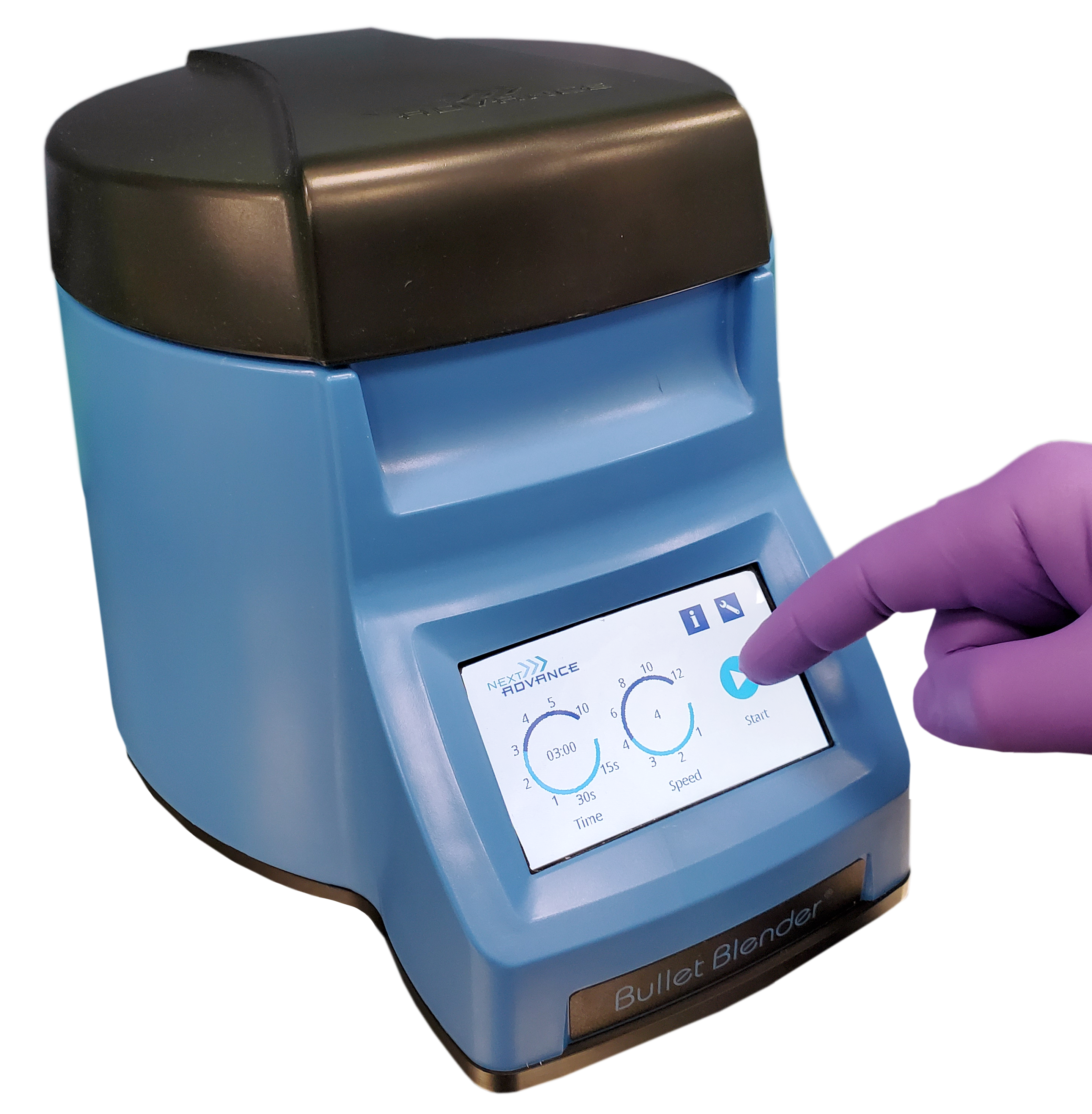
Want more guidance? Need a quote? Contact us:
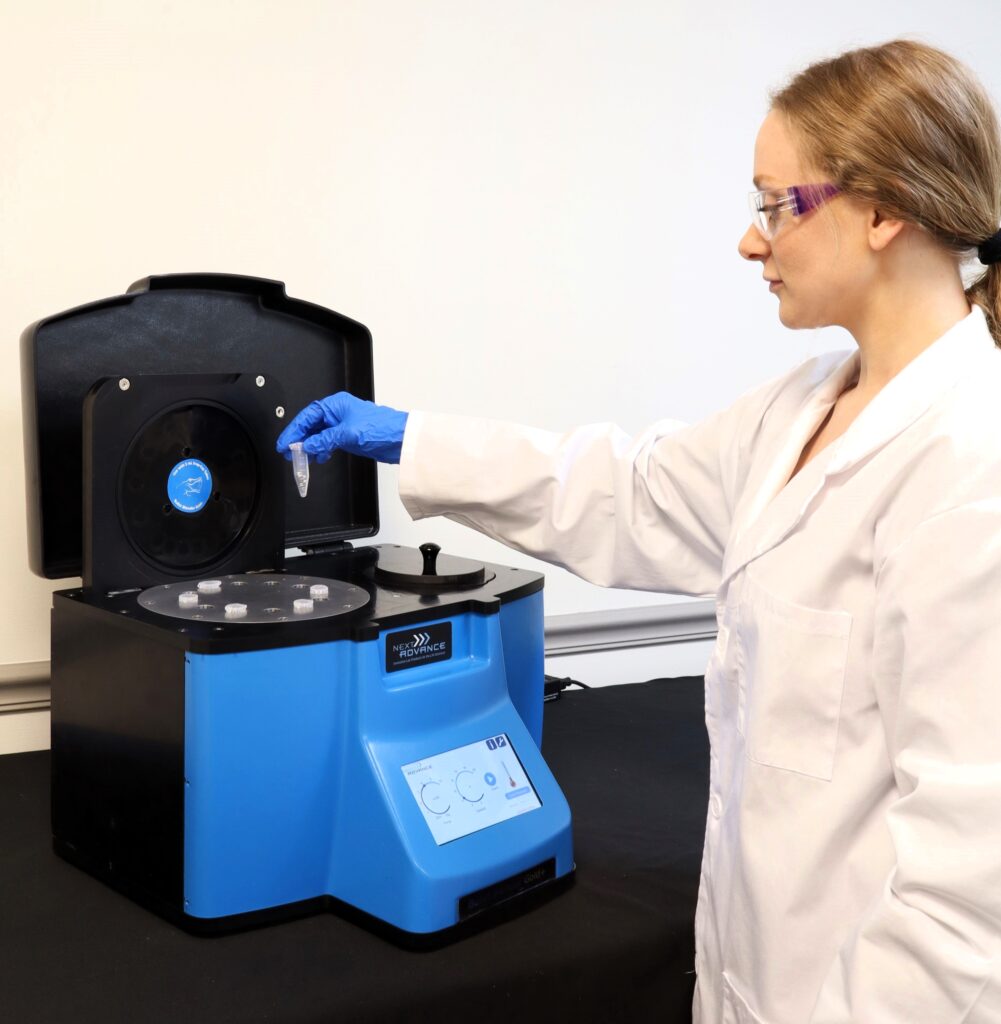
Bullet Blender Models
Select Publications Using the Bullet Blender to Isolate Intact Organelles
2474232
organelles
1
apa
50
date
desc
4104
https://www.nextadvance.com/wp-content/plugins/zotpress/
%7B%22status%22%3A%22success%22%2C%22updateneeded%22%3Afalse%2C%22instance%22%3Afalse%2C%22meta%22%3A%7B%22request_last%22%3A0%2C%22request_next%22%3A0%2C%22used_cache%22%3Atrue%7D%2C%22data%22%3A%5B%7B%22key%22%3A%22QKMNGX7B%22%2C%22library%22%3A%7B%22id%22%3A2474232%7D%2C%22meta%22%3A%7B%22creatorSummary%22%3A%22Zeng%20et%20al.%22%2C%22parsedDate%22%3A%222016-03-16%22%2C%22numChildren%22%3A2%7D%2C%22bib%22%3A%22%26lt%3Bdiv%20class%3D%26quot%3Bcsl-bib-body%26quot%3B%20style%3D%26quot%3Bline-height%3A%202%3B%20padding-left%3A%201em%3B%20text-indent%3A-1em%3B%26quot%3B%26gt%3B%5Cn%20%20%26lt%3Bdiv%20class%3D%26quot%3Bcsl-entry%26quot%3B%26gt%3BZeng%2C%20X.%2C%20Wang%2C%20H.%2C%20Xing%2C%20X.%2C%20Wang%2C%20Q.%2C%20%26amp%3B%20Li%2C%20W.%20%282016%29.%20Dexmedetomidine%20Protects%20against%20Transient%20Global%20Cerebral%20Ischemia%5C%2FReperfusion%20Induced%20Oxidative%20Stress%20and%20Inflammation%20in%20Diabetic%20Rats.%20%26lt%3Bi%26gt%3BPLOS%20ONE%26lt%3B%5C%2Fi%26gt%3B%2C%20%26lt%3Bi%26gt%3B11%26lt%3B%5C%2Fi%26gt%3B%283%29%2C%20e0151620.%20%26lt%3Ba%20class%3D%26%23039%3Bzp-DOIURL%26%23039%3B%20href%3D%26%23039%3Bhttps%3A%5C%2F%5C%2Fdoi.org%5C%2F10.1371%5C%2Fjournal.pone.0151620%26%23039%3B%26gt%3Bhttps%3A%5C%2F%5C%2Fdoi.org%5C%2F10.1371%5C%2Fjournal.pone.0151620%26lt%3B%5C%2Fa%26gt%3B%26lt%3B%5C%2Fdiv%26gt%3B%5Cn%26lt%3B%5C%2Fdiv%26gt%3B%22%2C%22data%22%3A%7B%22itemType%22%3A%22journalArticle%22%2C%22title%22%3A%22Dexmedetomidine%20Protects%20against%20Transient%20Global%20Cerebral%20Ischemia%5C%2FReperfusion%20Induced%20Oxidative%20Stress%20and%20Inflammation%20in%20Diabetic%20Rats%22%2C%22creators%22%3A%5B%7B%22creatorType%22%3A%22author%22%2C%22firstName%22%3A%22Xianzhang%22%2C%22lastName%22%3A%22Zeng%22%7D%2C%7B%22creatorType%22%3A%22author%22%2C%22firstName%22%3A%22Honglei%22%2C%22lastName%22%3A%22Wang%22%7D%2C%7B%22creatorType%22%3A%22author%22%2C%22firstName%22%3A%22Xichun%22%2C%22lastName%22%3A%22Xing%22%7D%2C%7B%22creatorType%22%3A%22author%22%2C%22firstName%22%3A%22Qi%22%2C%22lastName%22%3A%22Wang%22%7D%2C%7B%22creatorType%22%3A%22author%22%2C%22firstName%22%3A%22Wenzhi%22%2C%22lastName%22%3A%22Li%22%7D%5D%2C%22abstractNote%22%3A%22Background%20%20%20Transient%20global%20cerebral%20ischemia%5C%2Freperfusion%20%28I%5C%2FR%29%20is%20a%20major%20perioperative%20complication%2C%20and%20diabetes%20increases%20the%20response%20of%20oxidative%20stress%20and%20inflammation%20induced%20by%20I%5C%2FR.%20The%20objective%20of%20this%20study%20was%20to%20determine%20the%20protective%20effect%20of%20dexmedetomidine%20against%20transient%20global%20cerebral%20ischemia%5C%2Freperfusion%20induced%20oxidative%20stress%20and%20inflammation%20in%20diabetic%20rats.%20%20%20%20%20%20%20Methods%20%20%20Sixty-four%20rats%20were%20assigned%20into%20four%20experimental%20groups%3A%20normoglycemia%2C%20normoglycemia%20%2B%20dexmedetomidine%2C%20hyperglycemia%2C%20and%20hyperglycemia%20%2B%20dexmedetomidine%20and%20all%20subsequent%20neurological%20examinations%20were%20evaluated%20by%20a%20blinded%20observer.%20Damage%20to%20the%20brain%20was%20histologically%20assessed%20using%20the%20TUNEL%20staining%20method%20while%20western%20blotting%20was%20used%20to%20investigate%20changes%20in%20the%20expression%20levels%20of%20apoptosis-related%20proteins%20as%20well%20as%20the%20microglia%20marker%2C%20ionized%20calcium-binding%20adapter%20molecule%201%20%28Iba1%29.%20Water%20content%20in%20the%20brain%20was%20also%20analyzed.%20In%20addition%2C%20hippocampal%20concentrations%20of%20malondialdehyde%20%28MDA%29%20and%20Nox2%20%28a%20member%20of%20the%20Nox%20family%20of%20NADPH%20oxidases%29%2C%20and%20the%20activity%20of%20superoxide%20dismutase%20and%20catalase%20were%20analyzed.%20Finally%2C%20changes%20in%20serum%20concentrations%20of%20tumor%20necrosis%20factor-%5Cu03b1%20%28TNF-%5Cu03b1%29%20and%20interleukin%20%28IL%29-6%20were%20detected.%20%20%20%20%20%20%20Results%20%20%20Results%20showed%20that%20diabetes%20increased%20brain%20water%20content%2C%20the%20number%20of%20apoptotic%20neurons%2C%20early%20neurological%20deficit%20scores%2C%20oxidative%20stress%20%28MDA%20and%20Nox2%29%20and%20inflammation%20%28pro-inflammatory%20cytokines%20including%20TNF-%5Cu03b1%20and%20IL-6%29%20levels%20following%20transient%20global%20I%5C%2FR%20injury%2C%20but%20that%20these%20symptoms%20were%20attenuated%20following%20administration%20of%20dexmedetomidine.%20%20%20%20%20%20%20Conclusions%20%20%20These%20findings%20suggest%20that%20dexmedetomidine%20can%20significantly%20alleviate%20damage%20resulting%20from%20I%5C%2FR%2C%20and%20this%20mechanism%20may%20be%20related%20to%20a%20reduction%20in%20both%20oxidative%20stress%20and%20inflammation%20which%20is%20normally%20associated%20with%20I%5C%2FR.%22%2C%22date%22%3A%22Mar%2016%2C%202016%22%2C%22language%22%3A%22%22%2C%22DOI%22%3A%2210.1371%5C%2Fjournal.pone.0151620%22%2C%22ISSN%22%3A%221932-6203%22%2C%22url%22%3A%22http%3A%5C%2F%5C%2Fjournals.plos.org%5C%2Fplosone%5C%2Farticle%3Fid%3D10.1371%5C%2Fjournal.pone.0151620%22%2C%22collections%22%3A%5B%22M2MNG549%22%5D%2C%22dateModified%22%3A%222016-06-10T19%3A47%3A20Z%22%7D%7D%2C%7B%22key%22%3A%22XC2SPJ3M%22%2C%22library%22%3A%7B%22id%22%3A2474232%7D%2C%22meta%22%3A%7B%22creatorSummary%22%3A%22Drake%20et%20al.%22%2C%22parsedDate%22%3A%222014-11-01%22%2C%22numChildren%22%3A0%7D%2C%22bib%22%3A%22%26lt%3Bdiv%20class%3D%26quot%3Bcsl-bib-body%26quot%3B%20style%3D%26quot%3Bline-height%3A%202%3B%20padding-left%3A%201em%3B%20text-indent%3A-1em%3B%26quot%3B%26gt%3B%5Cn%20%20%26lt%3Bdiv%20class%3D%26quot%3Bcsl-entry%26quot%3B%26gt%3BDrake%2C%20J.%20C.%2C%20Bruns%2C%20D.%20R.%2C%20Peelor%2C%20F.%20F.%2C%20Biela%2C%20L.%20M.%2C%20Miller%2C%20R.%20A.%2C%20Hamilton%2C%20K.%20L.%2C%20%26amp%3B%20Miller%2C%20B.%20F.%20%282014%29.%20Long-lived%20crowded-litter%20mice%20have%20an%20age-dependent%20increase%20in%20protein%20synthesis%20to%20DNA%20synthesis%20ratio%20and%20mTORC1%20substrate%20phosphorylation.%20%26lt%3Bi%26gt%3BAJP%3A%20Endocrinology%20and%20Metabolism%26lt%3B%5C%2Fi%26gt%3B%2C%20%26lt%3Bi%26gt%3B307%26lt%3B%5C%2Fi%26gt%3B%289%29%2C%20E813%26%23x2013%3BE821.%20%26lt%3Ba%20class%3D%26%23039%3Bzp-DOIURL%26%23039%3B%20href%3D%26%23039%3Bhttps%3A%5C%2F%5C%2Fdoi.org%5C%2F10.1152%5C%2Fajpendo.00256.2014%26%23039%3B%26gt%3Bhttps%3A%5C%2F%5C%2Fdoi.org%5C%2F10.1152%5C%2Fajpendo.00256.2014%26lt%3B%5C%2Fa%26gt%3B%26lt%3B%5C%2Fdiv%26gt%3B%5Cn%26lt%3B%5C%2Fdiv%26gt%3B%22%2C%22data%22%3A%7B%22itemType%22%3A%22journalArticle%22%2C%22title%22%3A%22Long-lived%20crowded-litter%20mice%20have%20an%20age-dependent%20increase%20in%20protein%20synthesis%20to%20DNA%20synthesis%20ratio%20and%20mTORC1%20substrate%20phosphorylation%22%2C%22creators%22%3A%5B%7B%22creatorType%22%3A%22author%22%2C%22firstName%22%3A%22J.%20C.%22%2C%22lastName%22%3A%22Drake%22%7D%2C%7B%22creatorType%22%3A%22author%22%2C%22firstName%22%3A%22D.%20R.%22%2C%22lastName%22%3A%22Bruns%22%7D%2C%7B%22creatorType%22%3A%22author%22%2C%22firstName%22%3A%22F.%20F.%22%2C%22lastName%22%3A%22Peelor%22%7D%2C%7B%22creatorType%22%3A%22author%22%2C%22firstName%22%3A%22L.%20M.%22%2C%22lastName%22%3A%22Biela%22%7D%2C%7B%22creatorType%22%3A%22author%22%2C%22firstName%22%3A%22R.%20A.%22%2C%22lastName%22%3A%22Miller%22%7D%2C%7B%22creatorType%22%3A%22author%22%2C%22firstName%22%3A%22K.%20L.%22%2C%22lastName%22%3A%22Hamilton%22%7D%2C%7B%22creatorType%22%3A%22author%22%2C%22firstName%22%3A%22B.%20F.%22%2C%22lastName%22%3A%22Miller%22%7D%5D%2C%22abstractNote%22%3A%22%22%2C%22date%22%3A%222014-11-01%22%2C%22language%22%3A%22en%22%2C%22DOI%22%3A%2210.1152%5C%2Fajpendo.00256.2014%22%2C%22ISSN%22%3A%220193-1849%2C%201522-1555%22%2C%22url%22%3A%22http%3A%5C%2F%5C%2Fajpendo.physiology.org%5C%2Fcgi%5C%2Fdoi%5C%2F10.1152%5C%2Fajpendo.00256.2014%22%2C%22collections%22%3A%5B%22M2MNG549%22%5D%2C%22dateModified%22%3A%222015-12-01T16%3A23%3A55Z%22%7D%7D%2C%7B%22key%22%3A%22E8QDMRGM%22%2C%22library%22%3A%7B%22id%22%3A2474232%7D%2C%22meta%22%3A%7B%22creatorSummary%22%3A%22Al-Hasan%20et%20al.%22%2C%22parsedDate%22%3A%222013-03-01%22%2C%22numChildren%22%3A0%7D%2C%22bib%22%3A%22%26lt%3Bdiv%20class%3D%26quot%3Bcsl-bib-body%26quot%3B%20style%3D%26quot%3Bline-height%3A%202%3B%20padding-left%3A%201em%3B%20text-indent%3A-1em%3B%26quot%3B%26gt%3B%5Cn%20%20%26lt%3Bdiv%20class%3D%26quot%3Bcsl-entry%26quot%3B%26gt%3BAl-Hasan%2C%20Y.%20M.%2C%20Evans%2C%20L.%20C.%2C%20Pinkas%2C%20G.%20A.%2C%20Dabkowski%2C%20E.%20R.%2C%20Stanley%2C%20W.%20C.%2C%20%26amp%3B%20Thompson%2C%20L.%20P.%20%282013%29.%20Chronic%20Hypoxia%20Impairs%20Cytochrome%20Oxidase%20Activity%20Via%20Oxidative%20Stress%20in%20Selected%20Fetal%20Guinea%20Pig%20Organs.%20%26lt%3Bi%26gt%3BReproductive%20Sciences%26lt%3B%5C%2Fi%26gt%3B%2C%20%26lt%3Bi%26gt%3B20%26lt%3B%5C%2Fi%26gt%3B%283%29%2C%20299%26%23x2013%3B307.%20%26lt%3Ba%20class%3D%26%23039%3Bzp-DOIURL%26%23039%3B%20href%3D%26%23039%3Bhttps%3A%5C%2F%5C%2Fdoi.org%5C%2F10.1177%5C%2F1933719112453509%26%23039%3B%26gt%3Bhttps%3A%5C%2F%5C%2Fdoi.org%5C%2F10.1177%5C%2F1933719112453509%26lt%3B%5C%2Fa%26gt%3B%26lt%3B%5C%2Fdiv%26gt%3B%5Cn%26lt%3B%5C%2Fdiv%26gt%3B%22%2C%22data%22%3A%7B%22itemType%22%3A%22journalArticle%22%2C%22title%22%3A%22Chronic%20Hypoxia%20Impairs%20Cytochrome%20Oxidase%20Activity%20Via%20Oxidative%20Stress%20in%20Selected%20Fetal%20Guinea%20Pig%20Organs%22%2C%22creators%22%3A%5B%7B%22creatorType%22%3A%22author%22%2C%22firstName%22%3A%22Y.%20M.%22%2C%22lastName%22%3A%22Al-Hasan%22%7D%2C%7B%22creatorType%22%3A%22author%22%2C%22firstName%22%3A%22L.%20C.%22%2C%22lastName%22%3A%22Evans%22%7D%2C%7B%22creatorType%22%3A%22author%22%2C%22firstName%22%3A%22G.%20A.%22%2C%22lastName%22%3A%22Pinkas%22%7D%2C%7B%22creatorType%22%3A%22author%22%2C%22firstName%22%3A%22E.%20R.%22%2C%22lastName%22%3A%22Dabkowski%22%7D%2C%7B%22creatorType%22%3A%22author%22%2C%22firstName%22%3A%22W.%20C.%22%2C%22lastName%22%3A%22Stanley%22%7D%2C%7B%22creatorType%22%3A%22author%22%2C%22firstName%22%3A%22L.%20P.%22%2C%22lastName%22%3A%22Thompson%22%7D%5D%2C%22abstractNote%22%3A%22%22%2C%22date%22%3A%222013-03-01%22%2C%22language%22%3A%22en%22%2C%22DOI%22%3A%2210.1177%5C%2F1933719112453509%22%2C%22ISSN%22%3A%221933-7191%2C%201933-7205%22%2C%22url%22%3A%22http%3A%5C%2F%5C%2Frsx.sagepub.com%5C%2Fcgi%5C%2Fdoi%5C%2F10.1177%5C%2F1933719112453509%22%2C%22collections%22%3A%5B%22M2MNG549%22%5D%2C%22dateModified%22%3A%222015-07-23T14%3A58%3A38Z%22%7D%7D%2C%7B%22key%22%3A%22TZT2KDMI%22%2C%22library%22%3A%7B%22id%22%3A2474232%7D%2C%22meta%22%3A%7B%22creatorSummary%22%3A%22Diaz-Campos%22%2C%22parsedDate%22%3A%222012-08-04%22%2C%22numChildren%22%3A0%7D%2C%22bib%22%3A%22%26lt%3Bdiv%20class%3D%26quot%3Bcsl-bib-body%26quot%3B%20style%3D%26quot%3Bline-height%3A%202%3B%20padding-left%3A%201em%3B%20text-indent%3A-1em%3B%26quot%3B%26gt%3B%5Cn%20%20%26lt%3Bdiv%20class%3D%26quot%3Bcsl-entry%26quot%3B%26gt%3BDiaz-Campos%2C%20D.%20V.%20%282012%29.%20%26lt%3Bi%26gt%3BMolecular%20Epidemiology%20and%20Genetic%20Analysis%20of%20%26lt%3Bspan%20style%3D%26quot%3Bfont-style%3Anormal%3B%26quot%3B%26gt%3BStaphylococcus%26lt%3B%5C%2Fspan%26gt%3B%20species%20in%20Companion%20Animal%20Medicine%26lt%3B%5C%2Fi%26gt%3B.%20Auburn%20University.%26lt%3B%5C%2Fdiv%26gt%3B%5Cn%26lt%3B%5C%2Fdiv%26gt%3B%22%2C%22data%22%3A%7B%22itemType%22%3A%22thesis%22%2C%22title%22%3A%22Molecular%20Epidemiology%20and%20Genetic%20Analysis%20of%20%3Ci%3EStaphylococcus%3C%5C%2Fi%3E%20species%20in%20Companion%20Animal%20Medicine%22%2C%22creators%22%3A%5B%7B%22creatorType%22%3A%22author%22%2C%22firstName%22%3A%22Dubraska%20Vanessa%22%2C%22lastName%22%3A%22Diaz-Campos%22%7D%5D%2C%22abstractNote%22%3A%22%22%2C%22thesisType%22%3A%22%22%2C%22university%22%3A%22Auburn%20University%22%2C%22date%22%3A%2208%5C%2F04%5C%2F2012%22%2C%22language%22%3A%22%22%2C%22url%22%3A%22%22%2C%22collections%22%3A%5B%22M2MNG549%22%5D%2C%22dateModified%22%3A%222015-08-28T20%3A23%3A42Z%22%7D%7D%2C%7B%22key%22%3A%22X6Q3JC3F%22%2C%22library%22%3A%7B%22id%22%3A2474232%7D%2C%22meta%22%3A%7B%22creatorSummary%22%3A%22Sun%20et%20al.%22%2C%22parsedDate%22%3A%222012-03-01%22%2C%22numChildren%22%3A0%7D%2C%22bib%22%3A%22%26lt%3Bdiv%20class%3D%26quot%3Bcsl-bib-body%26quot%3B%20style%3D%26quot%3Bline-height%3A%202%3B%20padding-left%3A%201em%3B%20text-indent%3A-1em%3B%26quot%3B%26gt%3B%5Cn%20%20%26lt%3Bdiv%20class%3D%26quot%3Bcsl-entry%26quot%3B%26gt%3BSun%2C%20X.%2C%20Tang%2C%20Y.%2C%20Tan%2C%20X.%2C%20Li%2C%20Q.%2C%20Zhong%2C%20W.%2C%20Sun%2C%20X.%2C%20Jia%2C%20W.%2C%20McClain%2C%20C.%20J.%2C%20%26amp%3B%20Zhou%2C%20Z.%20%282012%29.%20Activation%20of%20peroxisome%20proliferator-activated%20receptor-%20by%20rosiglitazone%20improves%20lipid%20homeostasis%20at%20the%20adipose%20tissue-liver%20axis%20in%20ethanol-fed%20mice.%20%26lt%3Bi%26gt%3BAJP%3A%20Gastrointestinal%20and%20Liver%20Physiology%26lt%3B%5C%2Fi%26gt%3B%2C%20%26lt%3Bi%26gt%3B302%26lt%3B%5C%2Fi%26gt%3B%285%29%2C%20G548%26%23x2013%3BG557.%20%26lt%3Ba%20class%3D%26%23039%3Bzp-DOIURL%26%23039%3B%20href%3D%26%23039%3Bhttps%3A%5C%2F%5C%2Fdoi.org%5C%2F10.1152%5C%2Fajpgi.00342.2011%26%23039%3B%26gt%3Bhttps%3A%5C%2F%5C%2Fdoi.org%5C%2F10.1152%5C%2Fajpgi.00342.2011%26lt%3B%5C%2Fa%26gt%3B%26lt%3B%5C%2Fdiv%26gt%3B%5Cn%26lt%3B%5C%2Fdiv%26gt%3B%22%2C%22data%22%3A%7B%22itemType%22%3A%22journalArticle%22%2C%22title%22%3A%22Activation%20of%20peroxisome%20proliferator-activated%20receptor-%20by%20rosiglitazone%20improves%20lipid%20homeostasis%20at%20the%20adipose%20tissue-liver%20axis%20in%20ethanol-fed%20mice%22%2C%22creators%22%3A%5B%7B%22creatorType%22%3A%22author%22%2C%22firstName%22%3A%22X.%22%2C%22lastName%22%3A%22Sun%22%7D%2C%7B%22creatorType%22%3A%22author%22%2C%22firstName%22%3A%22Y.%22%2C%22lastName%22%3A%22Tang%22%7D%2C%7B%22creatorType%22%3A%22author%22%2C%22firstName%22%3A%22X.%22%2C%22lastName%22%3A%22Tan%22%7D%2C%7B%22creatorType%22%3A%22author%22%2C%22firstName%22%3A%22Q.%22%2C%22lastName%22%3A%22Li%22%7D%2C%7B%22creatorType%22%3A%22author%22%2C%22firstName%22%3A%22W.%22%2C%22lastName%22%3A%22Zhong%22%7D%2C%7B%22creatorType%22%3A%22author%22%2C%22firstName%22%3A%22X.%22%2C%22lastName%22%3A%22Sun%22%7D%2C%7B%22creatorType%22%3A%22author%22%2C%22firstName%22%3A%22W.%22%2C%22lastName%22%3A%22Jia%22%7D%2C%7B%22creatorType%22%3A%22author%22%2C%22firstName%22%3A%22C.%20J.%22%2C%22lastName%22%3A%22McClain%22%7D%2C%7B%22creatorType%22%3A%22author%22%2C%22firstName%22%3A%22Z.%22%2C%22lastName%22%3A%22Zhou%22%7D%5D%2C%22abstractNote%22%3A%22%22%2C%22date%22%3A%222012-03-01%22%2C%22language%22%3A%22en%22%2C%22DOI%22%3A%2210.1152%5C%2Fajpgi.00342.2011%22%2C%22ISSN%22%3A%220193-1857%2C%201522-1547%22%2C%22url%22%3A%22http%3A%5C%2F%5C%2Fajpgi.physiology.org%5C%2Fcgi%5C%2Fdoi%5C%2F10.1152%5C%2Fajpgi.00342.2011%22%2C%22collections%22%3A%5B%22M2MNG549%22%5D%2C%22dateModified%22%3A%222015-07-17T14%3A01%3A08Z%22%7D%7D%2C%7B%22key%22%3A%22AH3PGXQU%22%2C%22library%22%3A%7B%22id%22%3A2474232%7D%2C%22meta%22%3A%7B%22creatorSummary%22%3A%22Singh%20et%20al.%22%2C%22parsedDate%22%3A%222012%22%2C%22numChildren%22%3A0%7D%2C%22bib%22%3A%22%26lt%3Bdiv%20class%3D%26quot%3Bcsl-bib-body%26quot%3B%20style%3D%26quot%3Bline-height%3A%202%3B%20padding-left%3A%201em%3B%20text-indent%3A-1em%3B%26quot%3B%26gt%3B%5Cn%20%20%26lt%3Bdiv%20class%3D%26quot%3Bcsl-entry%26quot%3B%26gt%3BSingh%2C%20C.%2C%20Liu%2C%20L.%2C%20Wang%2C%20J.%20M.%2C%20Irwin%2C%20R.%20W.%2C%20Yao%2C%20J.%2C%20Chen%2C%20S.%2C%20Henry%2C%20S.%2C%20Thompson%2C%20R.%20F.%2C%20%26amp%3B%20Brinton%2C%20R.%20D.%20%282012%29.%20Allopregnanolone%20restores%20hippocampal-dependent%20learning%20and%20memory%20and%20neural%20progenitor%20survival%20in%20aging%203xTgAD%20and%20nonTg%20mice.%20%26lt%3Bi%26gt%3BNeurobiology%20of%20Aging%26lt%3B%5C%2Fi%26gt%3B%2C%20%26lt%3Bi%26gt%3B33%26lt%3B%5C%2Fi%26gt%3B%288%29%2C%201493%26%23x2013%3B1506.%20%26lt%3Ba%20class%3D%26%23039%3Bzp-DOIURL%26%23039%3B%20href%3D%26%23039%3Bhttps%3A%5C%2F%5C%2Fdoi.org%5C%2F10.1016%5C%2Fj.neurobiolaging.2011.06.008%26%23039%3B%26gt%3Bhttps%3A%5C%2F%5C%2Fdoi.org%5C%2F10.1016%5C%2Fj.neurobiolaging.2011.06.008%26lt%3B%5C%2Fa%26gt%3B%26lt%3B%5C%2Fdiv%26gt%3B%5Cn%26lt%3B%5C%2Fdiv%26gt%3B%22%2C%22data%22%3A%7B%22itemType%22%3A%22journalArticle%22%2C%22title%22%3A%22Allopregnanolone%20restores%20hippocampal-dependent%20learning%20and%20memory%20and%20neural%20progenitor%20survival%20in%20aging%203xTgAD%20and%20nonTg%20mice%22%2C%22creators%22%3A%5B%7B%22creatorType%22%3A%22author%22%2C%22firstName%22%3A%22Chanpreet%22%2C%22lastName%22%3A%22Singh%22%7D%2C%7B%22creatorType%22%3A%22author%22%2C%22firstName%22%3A%22Lifei%22%2C%22lastName%22%3A%22Liu%22%7D%2C%7B%22creatorType%22%3A%22author%22%2C%22firstName%22%3A%22Jun%20Ming%22%2C%22lastName%22%3A%22Wang%22%7D%2C%7B%22creatorType%22%3A%22author%22%2C%22firstName%22%3A%22Ronald%20W.%22%2C%22lastName%22%3A%22Irwin%22%7D%2C%7B%22creatorType%22%3A%22author%22%2C%22firstName%22%3A%22Jia%22%2C%22lastName%22%3A%22Yao%22%7D%2C%7B%22creatorType%22%3A%22author%22%2C%22firstName%22%3A%22Shuhua%22%2C%22lastName%22%3A%22Chen%22%7D%2C%7B%22creatorType%22%3A%22author%22%2C%22firstName%22%3A%22Sherry%22%2C%22lastName%22%3A%22Henry%22%7D%2C%7B%22creatorType%22%3A%22author%22%2C%22firstName%22%3A%22Richard%20F.%22%2C%22lastName%22%3A%22Thompson%22%7D%2C%7B%22creatorType%22%3A%22author%22%2C%22firstName%22%3A%22Roberta%20Diaz%22%2C%22lastName%22%3A%22Brinton%22%7D%5D%2C%22abstractNote%22%3A%22%22%2C%22date%22%3A%2208%5C%2F2012%22%2C%22language%22%3A%22en%22%2C%22DOI%22%3A%2210.1016%5C%2Fj.neurobiolaging.2011.06.008%22%2C%22ISSN%22%3A%2201974580%22%2C%22url%22%3A%22http%3A%5C%2F%5C%2Flinkinghub.elsevier.com%5C%2Fretrieve%5C%2Fpii%5C%2FS0197458011002247%22%2C%22collections%22%3A%5B%22M2MNG549%22%5D%2C%22dateModified%22%3A%222015-07-14T15%3A10%3A26Z%22%7D%7D%2C%7B%22key%22%3A%222SSMD7H9%22%2C%22library%22%3A%7B%22id%22%3A2474232%7D%2C%22meta%22%3A%7B%22creatorSummary%22%3A%22Miller%20et%20al.%22%2C%22parsedDate%22%3A%222012%22%2C%22numChildren%22%3A0%7D%2C%22bib%22%3A%22%26lt%3Bdiv%20class%3D%26quot%3Bcsl-bib-body%26quot%3B%20style%3D%26quot%3Bline-height%3A%202%3B%20padding-left%3A%201em%3B%20text-indent%3A-1em%3B%26quot%3B%26gt%3B%5Cn%20%20%26lt%3Bdiv%20class%3D%26quot%3Bcsl-entry%26quot%3B%26gt%3BMiller%2C%20B.%20F.%2C%20Robinson%2C%20M.%20M.%2C%20Bruss%2C%20M.%20D.%2C%20Hellerstein%2C%20M.%2C%20%26amp%3B%20Hamilton%2C%20K.%20L.%20%282012%29.%20A%20comprehensive%20assessment%20of%20mitochondrial%20protein%20synthesis%20and%20cellular%20proliferation%20with%20age%20and%20caloric%20restriction%3A%20Caloric%20restriction%20and%20mitochondrial%20synthesis.%20%26lt%3Bi%26gt%3BAging%20Cell%26lt%3B%5C%2Fi%26gt%3B%2C%20%26lt%3Bi%26gt%3B11%26lt%3B%5C%2Fi%26gt%3B%281%29%2C%20150%26%23x2013%3B161.%20%26lt%3Ba%20class%3D%26%23039%3Bzp-DOIURL%26%23039%3B%20href%3D%26%23039%3Bhttps%3A%5C%2F%5C%2Fdoi.org%5C%2F10.1111%5C%2Fj.1474-9726.2011.00769.x%26%23039%3B%26gt%3Bhttps%3A%5C%2F%5C%2Fdoi.org%5C%2F10.1111%5C%2Fj.1474-9726.2011.00769.x%26lt%3B%5C%2Fa%26gt%3B%26lt%3B%5C%2Fdiv%26gt%3B%5Cn%26lt%3B%5C%2Fdiv%26gt%3B%22%2C%22data%22%3A%7B%22itemType%22%3A%22journalArticle%22%2C%22title%22%3A%22A%20comprehensive%20assessment%20of%20mitochondrial%20protein%20synthesis%20and%20cellular%20proliferation%20with%20age%20and%20caloric%20restriction%3A%20Caloric%20restriction%20and%20mitochondrial%20synthesis%22%2C%22creators%22%3A%5B%7B%22creatorType%22%3A%22author%22%2C%22firstName%22%3A%22Benjamin%20F.%22%2C%22lastName%22%3A%22Miller%22%7D%2C%7B%22creatorType%22%3A%22author%22%2C%22firstName%22%3A%22Matthew%20M%22%2C%22lastName%22%3A%22Robinson%22%7D%2C%7B%22creatorType%22%3A%22author%22%2C%22firstName%22%3A%22Matthew%20D.%22%2C%22lastName%22%3A%22Bruss%22%7D%2C%7B%22creatorType%22%3A%22author%22%2C%22firstName%22%3A%22Marc%22%2C%22lastName%22%3A%22Hellerstein%22%7D%2C%7B%22creatorType%22%3A%22author%22%2C%22firstName%22%3A%22Karyn%20L.%22%2C%22lastName%22%3A%22Hamilton%22%7D%5D%2C%22abstractNote%22%3A%22%22%2C%22date%22%3A%2202%5C%2F2012%22%2C%22language%22%3A%22en%22%2C%22DOI%22%3A%2210.1111%5C%2Fj.1474-9726.2011.00769.x%22%2C%22ISSN%22%3A%2214749718%22%2C%22url%22%3A%22http%3A%5C%2F%5C%2Fdoi.wiley.com%5C%2F10.1111%5C%2Fj.1474-9726.2011.00769.x%22%2C%22collections%22%3A%5B%22M2MNG549%22%5D%2C%22dateModified%22%3A%222015-07-21T14%3A18%3A10Z%22%7D%7D%2C%7B%22key%22%3A%222NFBC96J%22%2C%22library%22%3A%7B%22id%22%3A2474232%7D%2C%22meta%22%3A%7B%22creatorSummary%22%3A%22Singh%22%2C%22parsedDate%22%3A%222010%22%2C%22numChildren%22%3A0%7D%2C%22bib%22%3A%22%26lt%3Bdiv%20class%3D%26quot%3Bcsl-bib-body%26quot%3B%20style%3D%26quot%3Bline-height%3A%202%3B%20padding-left%3A%201em%3B%20text-indent%3A-1em%3B%26quot%3B%26gt%3B%5Cn%20%20%26lt%3Bdiv%20class%3D%26quot%3Bcsl-entry%26quot%3B%26gt%3BSingh%2C%20C.%20%282010%29.%20%26lt%3Bi%26gt%3BMemory%20abnormalities%20in%20Alzheimer%26%23x2019%3Bs%20disease%20and%20anxiety%20models%26lt%3B%5C%2Fi%26gt%3B.%20University%20of%20Southern%20California.%26lt%3B%5C%2Fdiv%26gt%3B%5Cn%26lt%3B%5C%2Fdiv%26gt%3B%22%2C%22data%22%3A%7B%22itemType%22%3A%22thesis%22%2C%22title%22%3A%22Memory%20abnormalities%20in%20Alzheimer%27s%20disease%20and%20anxiety%20models%22%2C%22creators%22%3A%5B%7B%22creatorType%22%3A%22author%22%2C%22firstName%22%3A%22Chanpreet%22%2C%22lastName%22%3A%22Singh%22%7D%5D%2C%22abstractNote%22%3A%22%22%2C%22thesisType%22%3A%22%22%2C%22university%22%3A%22University%20of%20Southern%20California%22%2C%22date%22%3A%225%5C%2F2010%22%2C%22language%22%3A%22%22%2C%22url%22%3A%22%22%2C%22collections%22%3A%5B%22M2MNG549%22%5D%2C%22dateModified%22%3A%222015-08-31T19%3A37%3A00Z%22%7D%7D%2C%7B%22key%22%3A%229WCNNSV3%22%2C%22library%22%3A%7B%22id%22%3A2474232%7D%2C%22meta%22%3A%7B%22creatorSummary%22%3A%22Henry%20et%20al.%22%2C%22parsedDate%22%3A%222009-12%22%2C%22numChildren%22%3A0%7D%2C%22bib%22%3A%22%26lt%3Bdiv%20class%3D%26quot%3Bcsl-bib-body%26quot%3B%20style%3D%26quot%3Bline-height%3A%202%3B%20padding-left%3A%201em%3B%20text-indent%3A-1em%3B%26quot%3B%26gt%3B%5Cn%20%20%26lt%3Bdiv%20class%3D%26quot%3Bcsl-entry%26quot%3B%26gt%3BHenry%2C%20S.%2C%20Bigler%2C%20S.%2C%20%26amp%3B%20Wang%2C%20J.%20%282009%29.%20High%20throughput%20analysis%20of%20neural%20progenitor%20cell%20proliferation%20in%20adult%20rodent%20hippocampus.%20%26lt%3Bi%26gt%3BBioscience%20Trends%26lt%3B%5C%2Fi%26gt%3B%2C%20%26lt%3Bi%26gt%3B3%26lt%3B%5C%2Fi%26gt%3B%286%29%2C%20233%26%23x2013%3B238.%26lt%3B%5C%2Fdiv%26gt%3B%5Cn%26lt%3B%5C%2Fdiv%26gt%3B%22%2C%22data%22%3A%7B%22itemType%22%3A%22journalArticle%22%2C%22title%22%3A%22High%20throughput%20analysis%20of%20neural%20progenitor%20cell%20proliferation%20in%20adult%20rodent%20hippocampus%22%2C%22creators%22%3A%5B%7B%22creatorType%22%3A%22author%22%2C%22firstName%22%3A%22Sherry%22%2C%22lastName%22%3A%22Henry%22%7D%2C%7B%22creatorType%22%3A%22author%22%2C%22firstName%22%3A%22Steven%22%2C%22lastName%22%3A%22Bigler%22%7D%2C%7B%22creatorType%22%3A%22author%22%2C%22firstName%22%3A%22Junming%22%2C%22lastName%22%3A%22Wang%22%7D%5D%2C%22abstractNote%22%3A%22Extensive%20efforts%20have%20been%20made%20to%20determine%20the%20status%20on%20neural%20progenitor%20cell%20proliferation%20in%20specific%20pathological%20conditions%20and%20to%20evaluate%20the%20therapeutic%20efficacy%20of%20drugs%20for%20preventing%20neurogenic%20deficits%20in%20neurodegenerative%20diseases.%20However%2C%20the%20most%20commonly%20used%20stereological%20analysis%20using%205-bromo-2%26%23039%3B-deoxyuridine%20%28BrdU%29%20immuno-positive%20sections%20is%20a%20time%20consuming%20and%20labor%20intensive%20process%20and%20is%20often%20a%20bottle%20neck%20in%20neurogenic%20drug%20development%2C%20particularly%20when%20large%20sample%20sizes%20are%20needed.%20In%20addition%2C%20BrdU%20is%20toxic%20to%20new%20born%20neurons%20and%20also%20labels%20DNA%20damage%20in%20old%20cells.%20In%20this%20study%2C%20we%20established%20a%20method%20that%20quantitatively%20measures%20the%20number%20of%20Ki-67%2C%20an%20endogenous%20cell%20proliferation%20marker%2C%20positive%20cells%20by%20flow%20cytometry%20which%20analyzes%20extracted%20cell%20nuclei%20from%20rodent%20hippocampi%20in%20suspension.%20Our%20results%20demonstrate%20that%20this%20approach%20can%20be%20applied%20to%20a%20large%20number%20of%20rodent%20samples%2C%20can%20be%20accomplished%20in%20a%20short%20period%20of%20time%20%281-3%20days%29%2C%20and%20can%20be%20completed%20in%20a%20more%20accurately%20objective%20manner%20than%20by%20using%203-D%20cell%20counting%20with%20immunohistochemically%20processed%20sections.%22%2C%22date%22%3A%22Dec%202009%22%2C%22language%22%3A%22eng%22%2C%22DOI%22%3A%22%22%2C%22ISSN%22%3A%221881-7823%22%2C%22url%22%3A%22%22%2C%22collections%22%3A%5B%22M2MNG549%22%5D%2C%22dateModified%22%3A%222015-07-29T15%3A10%3A20Z%22%7D%7D%5D%7D
Zeng, X., Wang, H., Xing, X., Wang, Q., & Li, W. (2016). Dexmedetomidine Protects against Transient Global Cerebral Ischemia/Reperfusion Induced Oxidative Stress and Inflammation in Diabetic Rats. PLOS ONE, 11(3), e0151620. https://doi.org/10.1371/journal.pone.0151620
Drake, J. C., Bruns, D. R., Peelor, F. F., Biela, L. M., Miller, R. A., Hamilton, K. L., & Miller, B. F. (2014). Long-lived crowded-litter mice have an age-dependent increase in protein synthesis to DNA synthesis ratio and mTORC1 substrate phosphorylation. AJP: Endocrinology and Metabolism, 307(9), E813–E821. https://doi.org/10.1152/ajpendo.00256.2014
Al-Hasan, Y. M., Evans, L. C., Pinkas, G. A., Dabkowski, E. R., Stanley, W. C., & Thompson, L. P. (2013). Chronic Hypoxia Impairs Cytochrome Oxidase Activity Via Oxidative Stress in Selected Fetal Guinea Pig Organs. Reproductive Sciences, 20(3), 299–307. https://doi.org/10.1177/1933719112453509
Diaz-Campos, D. V. (2012). Molecular Epidemiology and Genetic Analysis of Staphylococcus species in Companion Animal Medicine. Auburn University.
Sun, X., Tang, Y., Tan, X., Li, Q., Zhong, W., Sun, X., Jia, W., McClain, C. J., & Zhou, Z. (2012). Activation of peroxisome proliferator-activated receptor- by rosiglitazone improves lipid homeostasis at the adipose tissue-liver axis in ethanol-fed mice. AJP: Gastrointestinal and Liver Physiology, 302(5), G548–G557. https://doi.org/10.1152/ajpgi.00342.2011
Singh, C., Liu, L., Wang, J. M., Irwin, R. W., Yao, J., Chen, S., Henry, S., Thompson, R. F., & Brinton, R. D. (2012). Allopregnanolone restores hippocampal-dependent learning and memory and neural progenitor survival in aging 3xTgAD and nonTg mice. Neurobiology of Aging, 33(8), 1493–1506. https://doi.org/10.1016/j.neurobiolaging.2011.06.008
Miller, B. F., Robinson, M. M., Bruss, M. D., Hellerstein, M., & Hamilton, K. L. (2012). A comprehensive assessment of mitochondrial protein synthesis and cellular proliferation with age and caloric restriction: Caloric restriction and mitochondrial synthesis. Aging Cell, 11(1), 150–161. https://doi.org/10.1111/j.1474-9726.2011.00769.x
Singh, C. (2010). Memory abnormalities in Alzheimer’s disease and anxiety models. University of Southern California.
Henry, S., Bigler, S., & Wang, J. (2009). High throughput analysis of neural progenitor cell proliferation in adult rodent hippocampus. Bioscience Trends, 3(6), 233–238.

